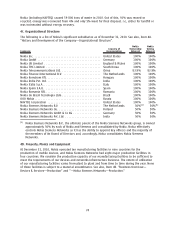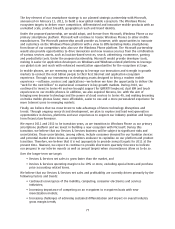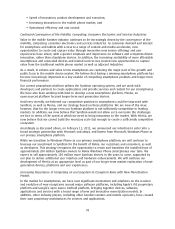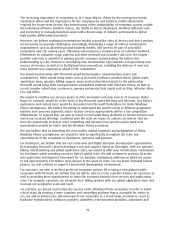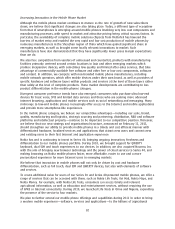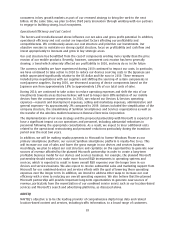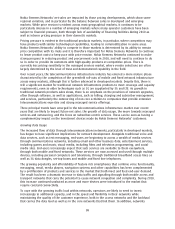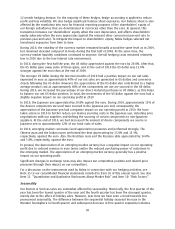Nokia 2010 Annual Report Download - page 85
Download and view the complete annual report
Please find page 85 of the 2010 Nokia annual report below. You can navigate through the pages in the report by either clicking on the pages listed below, or by using the keyword search tool below to find specific information within the annual report.NAVTEQ’s strategy is to enhance and expand its geographic database and related dynamic content and
services, thereby enabling NAVTEQ to grow its presence in applications and services created by mobile
device manufacturers, automotive manufacturers, navigation system and application vendors and
Internet application providers. Through NAVTEQ, we are ensuring the continued development of our
context and geographical services through Ovi Maps as we move from simple navigation to a broader
range of locationbased services, such as pedestrian navigation, traffic and public transport
information, local services and city guides, integration with social networks and contextual
advertising. Our Devices & Services business is a key customer of NAVTEQ. Devices & Services
purchases map licenses from NAVTEQ for its Ovi Maps service sold in combination with GPS enabled
smartphones.
At the same time, NAVTEQ continues to develop its expertise in digital mapping and navigation,
service its external customer base and invest in the further development of its map data, location
based services, mobile advertising capabilities and technology platform.
LocationBased Products and Services Proliferating
A substantial majority of NAVTEQ’s net sales comes from the licensing of NAVTEQ’s digital map data and
related locationbased content and services for use in mobile devices, invehicle navigation systems,
Internet applications, geographical information system applications and other locationbased products
and services. NAVTEQ’s success depends upon the development of a wide variety of products and
services that use its data, the availability and functionality of such products and services and the rate at
which consumers and businesses purchase these products and services. In recent years, there has been
an overwhelming increase in the availability of such products and services, particularly in mobile
devices and online application stores for such devices. We expect this trend to continue, but we also
expect that the level of quality required for these products and services and the ability to charge license
fees for the use of map data incorporated into such products and services may vary significantly.
Price Pressure for Navigable Map Data Increasing
NAVTEQ net sales are also impacted by the highly competitive pricing environment. Google is now
offering turnbyturn navigation for many countries to its business customers and consumers on
certain mobile handsets at no charge to the consumer. In January 2010, Nokia introduced a new
version of Ovi Maps for its selected smartphones that includes highend walk and drive navigation at
no extra cost to the consumer. We expect these offerings will increase the adoption of locationbased
services in the mobile handset industry, but we also expect it may result in additional price pressure
from NAVTEQ’s other business customers, including handset manufacturers, navigation application
developers, wireless carriers and personal navigation device (“PND”) manufacturers, seeking ways to
offer lowercost or free turnbyturn navigation to consumers. Turnbyturn navigation solutions that
are free to consumers on mobile devices may also put pressure on automotive OEMs and automotive
navigation system manufacturers to have lower cost navigation alternatives. The price pressure will
likely result in an increased focus on advertising revenue as a way to supplement or replace license
fees for map data.
In response to the pricing pressure, NAVTEQ focuses on offering a digital map database with superior
quality, detail and coverage; providing valueadded services to its customers such as distribution and
technical services; enhancing and extending its product offering by adding additional content to its
map database, such as 3D landmarks, and providing business customers with alternative business
models that are less onerous to the business customer than those provided by competitors. NAVTEQ’s
future results will also depend on NAVTEQ’s ability to adapt its business models to generate
increasing amounts of advertising revenues from its map and other locationbased content.
We believe that NAVTEQ’s PND customers will continue to face competitive pressure from
smartphones and other mobile devices that now offer navigation, but that PNDs currently offer a
strong value proposition for consumers based on the functionality, user interface, quality and overall
ease of use.
84


